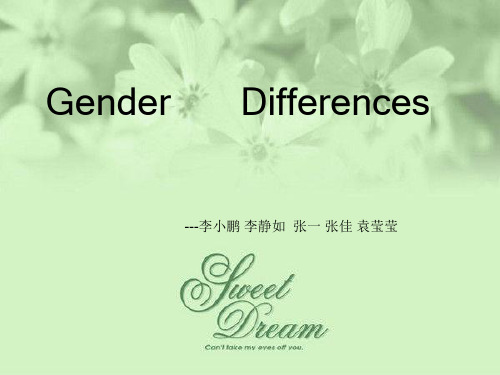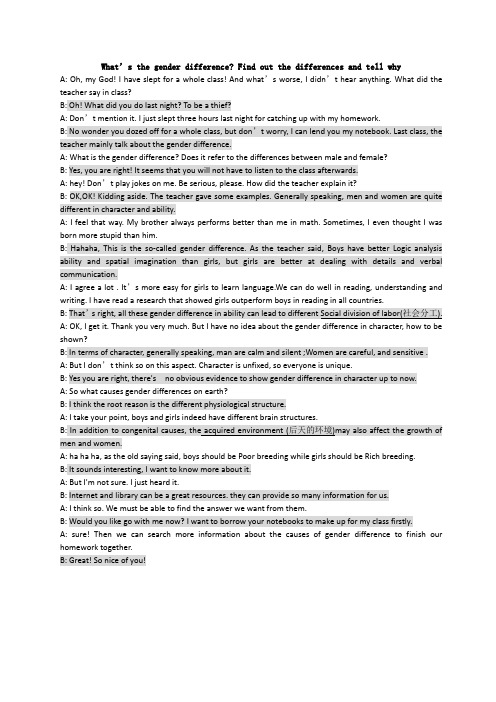gender difference
- 格式:ppt
- 大小:4.82 MB
- 文档页数:42



Unit 3 Gender DifferenceGender Roles from a Cultural PerspectiveOver the past few decades, it has been proven innumerable times that the various types of behavior, emotions, and interests that constitute being masculine and feminine are patterned by both heredity and culture. In the process of growing up, each child learns hundreds of culturally patterned details of behavior that become incorporated into its gender identity. Some of this learning takes place directly. In other words, the child is told by others how to act in an appropriately feminine or masculine way. Other details of gender behavior are taught unconsciously, or indirectly, as the culture provides different images, aspirations, and adult models for girls and boys.Recently, for example, a study of American public schools showed that there is a cultural bias in education that favors boys over girls. According to the researchers, the bias is unintentional and unconscious, but it is there and it is influencing the lives of millions of schoolchildren every year. Doctors David and Myra Sadker videotaped classroom teachers in order to study gender-related bias in education. Their research showed that many teachers who thought they were nonsexist were amazed to see how biased they appeared on videotape. From nursery school to postgraduate courses, teachers were shown to call on males in class far more than on female students. This has a tremendous impact on the learning process for, in general, those students who become active classroom participants develop more positive attitudes and go on to higher achievement. As a matter of fact, in the late 1960s, when many of the best all-women's colleges in the northeastern United States opened their doors to male students, it was observed by professors and women students alike that the boys were "taking over" the classroom discussions and that active participation by women students had diminished noticeably. A similar subordination of female to male students has also been observed in law and medical school classrooms in recent years.3 Research done by the Sadkers showed that sometimes teachers unknowingly prevented girls from participating as actively as boys in class by assigning them different tasks in accordance with stereotyped gender roles. For instance, one teacher conducting a science class with nursery school youngsters, continually had the little boys perform the scientific "experiment" while the girls were given the task of putting the materials away. Since hands-on work with classroom materials is a very important aspect of early education, the girls were thus being deprived of a vital learning experience that would affect their entire lives.Another dimension of gender-biased education is the typical American teacher's assumption that boys will do better in the "hard", "masculine" subjects of math and science while girls are expected to have better verbal and reading skills. As an example of a self-fulfilling prophecy, American boys do, indeed, develop reading problems, while girls, who are superior to boys in math up to the age of nine, fall behind from then on. But these are cultural, not genetic patterns. In Germany, for example, all studies are considered "masculine", and it is girls who develop reading problems. And in Japan, where early education appears to be nonsexist, both girls and boys do equally well in reading.The different attitudes associated with the educational process for girls and boys begin at home. One study, for example, showed that when preschoolers were asked to look at a picture of a house and tell how far away from the house they were permitted to go, the boys indicated a much wider area than the girls, who generally pointed out a very limited area close to the home. Instead of being encouraged to develop intellectual curiosity and physical skills that are useful in dealing with the outside world, as boys are, girls are filled with fears of the world outside the home and with the desire to be approved of for their "goodness" and obedience to rules. These lessons carry over from the home to the classroom, where girls are generally observed to be more dependent on the teacher, more concerned with the form and neatness of their work than with its content, and more anxious about being "right" in their answers than in being intellectually independent, analytical, or original. Thus, through the educational process that occupies most of the child's waking hours, society reinforces its established values and turns out each gender in its traditional and expected mold.从文化角度看性别角色1 在过去的几十年里,已经无数次地证实了这样一个事实:构成男子阳刚之气和女子阴柔之气的各种不同类型的行为、情感、和兴趣都既是遗传又是文化熏陶的结果。

Unit 3 Gender DifferenceGender Roles from a Cultural PerspectiveOver the past few decades, it has been proven innumerable times that the various types of behavior, emotions, and interests that constitute being masculine and feminine are patterned by both heredity and culture. In the process of growing up, each child learns hundreds of culturally patterned details of behavior that become incorporated into its gender identity. Some of this learning takes place directly. In other words, the child is told by others how to act in an appropriately feminine or masculine way. Other details of gender behavior are taught unconsciously, or indirectly, as the culture provides different images, aspirations, and adult models for girls and boys.Recently, for example, a study of American public schools showed that there is a cultural bias in education that favors boys over girls. According to the researchers, the bias is unintentional and unconscious, but it is there and it is influencing the lives of millions of schoolchildren every year. Doctors David and Myra Sadker videotaped classroom teachers in order to study gender-related bias in education. Their research showed that many teachers who thought they were nonsexist were amazed to see how biased they appeared on videotape. From nursery school to postgraduate courses, teachers were shown to call on males in class far more than on female students. This has a tremendous impact on the learning process for, in general, those students who become active classroom participants develop more positive attitudes and go on to higher achievement. As a matter of fact, in the late 1960s, when many of the best all-women's colleges in the northeastern United States opened their doors to male students, it was observed by professors and women students alike that the boys were "taking over" the classroom discussions and that active participation by women students had diminished noticeably. A similar subordination of female to male students has also been observed in law and medical school classrooms in recent years.3 Research done by the Sadkers showed that sometimes teachers unknowingly prevented girls from participating as actively as boys in class by assigning them different tasks in accordance with stereotyped gender roles. For instance, one teacher conducting a science class with nursery school youngsters, continually had the little boys perform the scientific "experiment" while the girls were given the task of putting the materials away. Since hands-on work with classroom materials is a very important aspect of early education, the girls were thus being deprived of a vital learning experience that would affect their entire lives.Another dimension of gender-biased education is the typical American teacher's assumption that boys will do better in the "hard", "masculine" subjects of math and science while girls are expected to have better verbal and reading skills. As an example of a self-fulfilling prophecy, American boys do, indeed, develop reading problems, while girls, who are superior to boys in math up to the age of nine, fall behind from then on. But these are cultural, not genetic patterns. In Germany, for example, all studies are considered "masculine", and it is girls who develop reading problems. And in Japan, where early education appears to be nonsexist, both girls and boys do equally well in reading.The different attitudes associated with the educational process for girls and boys begin at home. One study, for example, showed that when preschoolers were asked to look at a picture of a house and tell how far away from the house they were permitted to go, the boys indicated a much wider area than the girls, who generally pointed out a very limited area close to the home. Instead of being encouraged to develop intellectual curiosity and physical skills that are useful in dealing with the outside world, as boys are, girls are filled with fears of the world outside the home and with the desire to be approved of for their "goodness" and obedience to rules. These lessons carry over from the home to the classroom, where girls are generally observed to be more dependent on the teacher, more concerned with the form and neatness of their work than with its content, and more anxious about being "right" in their answers than in being intellectually independent, analytical, or original. Thus, through the educational process that occupies most of the child's waking hours, society reinforces its established values and turns out each gender in its traditional and expected mold.从文化角度看性别角色1 在过去的几十年里,已经无数次地证实了这样一个事实:构成男子阳刚之气和女子阴柔之气的各种不同类型的行为、情感、和兴趣都既是遗传又是文化熏陶的结果。

What’s the gender difference? Find out the differences and tell whyA: Oh, my God! I have slept for a whole class! And what’s worse, I didn’t hear anything. What did the teacher say in class?B: Oh! What did you do last night? To be a thief?A: Don’t mention it. I just slept three hours last night for catching up with my homework.B: No wonder you dozed off for a whole class, but don’t worry, I can lend you my notebook. Last class, the teacher mainly talk about the gender difference.A: What is the gender difference? Does it refer to the differences between male and female?B: Yes, you are right! It seems that you will not have to listen to the class afterwards.A: hey! Don’t play jokes on me. Be serious, please. How did the teacher explain it?B: OK,OK! Kidding aside. The teacher gave some examples. Generally speaking, men and women are quite different in character and ability.A: I feel that way. My brother always performs better than me in math. Sometimes, I even thought I was born more stupid than him.B: Hahaha, This is the so-called gender difference. As the teacher said, Boys have better Logic analysis ability and spatial imagination than girls, but girls are better at dealing with details and verbal communication.A: I agree a lot . It’s more easy for girls to learn language.We can do well in reading, understanding and writing. I have read a research that showed girls outperform boys in reading in all countries.A: OK, I get it. Thank you very much. But I have no idea about the gender difference in character, how to be shown?B: In terms of character, generally speaking, man are calm and silent ;Women are careful, and sensitive . A: But I don’t think so on this aspect. Character is unfixed, so everyone is unique.B: Yes you are right, there's no obvious evidence to show gender difference in character up to now.A: So what causes gender differences on earth?B: I think the root reason is the different physiological structure.A: I take your point, boys and girls indeed have different brain structures.B: In addition to congenital causes, the acquired environment (后天的环境)may also affect the growth of men and women.A: ha ha ha, as the old saying said, boys should be Poor breeding while girls should be Rich breeding.B: It sounds interesting, I want to know more about it.A: But I'm not sure. I just heard it.B: Internet and library can be a great resources. they can provide so many information for us.A: I think so. We must be able to find the answer we want from them.B: Would you like go with me now? I want to borrow your notebooks to make up for my class firstly.A: sure! Then we can search more information about the causes of gender difference to finish our homework together.B: Great! So nice of you!。

性别差异英语作文Gender Differences。
Gender differences have been a topic of debate for many years. Men and women are different in many ways, including their physical, emotional, and mental characteristics. These differences can be attributed to biological, social, and cultural factors.One of the most obvious gender differences is physical strength. Men are generally stronger than women due totheir larger muscle mass and bone density. This difference can be seen in sports, where men dominate in events requiring physical strength and endurance. However, women have certain physical advantages, such as greaterflexibility and a lower center of gravity, which make them better suited for some sports.Emotional differences between men and women are also apparent. Women are often considered more emotional andempathetic than men. They tend to be more in touch with their feelings and express them more openly. Men, on the other hand, are often more reserved and less likely to share their emotions. This difference can be attributed to social and cultural factors, as men are often taught to be stoic and unemotional.Mental differences between men and women are lessclear-cut. Some studies suggest that men are better at spatial tasks, while women are better at verbal tasks. However, these differences are not absolute, and there is a great deal of overlap between the sexes. It is also important to note that these differences may be influenced by cultural and environmental factors, such as education and upbringing.Gender differences can have both positive and negative effects. On the one hand, they can lead to greaterdiversity and complementarity in relationships and workplaces. On the other hand, they can also lead to stereotypes and discrimination. It is important to recognize and appreciate the differences between men andwomen while also promoting equality and respect for all individuals.In conclusion, gender differences are a complex and multifaceted topic. While there are observable differences between men and women, it is important to recognize that these differences are not absolute and may be influenced by social, cultural, and environmental factors. By promoting equality and respect for all individuals, we can create a more inclusive and harmonious society.。
性别差异的原因英语作文Title: The Causes of Gender DifferencesGender differences have been a topic of interest and debate in various societies and cultures. These differences can be attributed to a multitude of factors, both biological and socio-cultural. This essay aims to explore the causes behind gender differences.Biologically, the most apparent difference between genders is the distinct reproductive systems. Hormonal variations, particularly the levels of testosterone and estrogen, play a significant role in shaping the physical and behavioral characteristics of individuals. From birth, these hormonal differences contribute to the development of gender-specific traits and tendencies.Socio-culturally, gender differences are largely influenced by societal norms, expectations, and roles. These are deeply ingrained in the fabric of a society and are passed down through generations. The concept of gender roles dictating the behavior, responsibilities, and opportunities available to individuals based on their gender. For instance, in many cultures, men are expected to be strong, assertive, and providers, while women are associated with nurturing, empathy, and domestic responsibilities.One of the primary causes of gender differences is the socialization process. From a young age, children are taught societal norms andexpectations related to their gender. This socialization occurs within the family, educational institutions, media, and religious institutions. These agents of socialization reinforce gender stereotypes, limiting the scope of individual expression and potential.Education also plays a significant role in perpetuating gender differences. In many societies, there is a divide in the subjects boys and girls are encouraged to study. This division leads to differences in career choices and opportunities, further reinforcing gender-specific roles.The workplace environment contributes to gender differences as well. Gender discrimination and biases result in unequal pay, fewer opportunities for women in leadership positions, and a lack of flexibility for balancing work and family responsibilities. These barriers not only affect women's professional growth but also reinforce traditional gender roles.Media and popular culture play a pivotal role in shaping and perpetuating gender differences. Stereotypical representations of genders in movies, television shows, and advertisements reinforce societal expectations and limit the scope for diverse gender expressions.In conclusion, the causes of gender differences are multifaceted, encompassing both biological and socio-cultural factors. Hormonal differences, societal norms, gender roles, socialization, education, workplace biases, and media representations all contribute to theexistence and perpetuation of gender differences. Recognizing and understanding these causes is crucial for creating a more inclusive and equitable society that allows individuals to express their genders freely and equally.。
GENDER DIFFERENCES AND TRANSLATIONAbstractGendered language refers to the phenomenon that there exist gender differences in natural language. And this is inevitably reflected in translation. This paper analyses different translations of an same article to see how a translator obtains self-identity through lexical selection. Due to the influence of patriarchy, a male translator uses derogatory terms instead of neutral ones to show mean’s superiority over woman while a female translator usually expresses self-consciousness and self-identity through lexical selection. The reflection of gender differences in language is a kind of speech act. This is a significant act to reveal this phenomenon in translation. Besides, how this phenomenon exist is another important part in this thesis. The last part is analysis of women’s consciousness of independence in the three Bronte Sisters’works.Key words: Gender language; Gender difference; Different translations work of man and woman; Women’s consciousness性别差异与翻译摘要性别语言是指自然语言中存在于不同性别之间差异现象,并且这种差异会不可避免的反映到翻译中。
翻译与性别之间的关系自20世纪90年代翻译研究发生“文化转向”以来,从文化视角进行的翻译研究日益深入,结出了累累硕果。
性别与翻译的结合,正是这次转向后文化研究与翻译研究联姻的一个重要组成部分,也是当前翻译研究一个日益突出的发展方向。
这里的“性别”,指伴随着女性主义运动逐步发展起来的“社会性别”(gender)概念。
女性主义认为性别有生理性别与社会性别之分,生理性别与生俱来,社会性别则由社会、文化因素后天塑造而成。
“性别”在语言中可以理解为自然的性别差异(Sex difference)和社会的性别差异(Gender difference),语言的性别差异很早就为语言学家所注意。
从20 世纪60 年代中期起,语言学家们开始对语言和性别问题进行系统研究,他们借用社会学常用的统计调查方法,调查分析人的性别因素对语言的影响。
分析表明,性别因素以某种特定的方式影响着人们的语言行为,女性无论从语音、词汇还是语法方面,都更注重语言的准确性,更注意语言的文雅、含蓄和委婉。
同时,夸张修饰语的应用和语调的变换,也显示出女性语言中含有较多的情感因素。
传统的翻译观建立在原作/复制、作者/译者等二元对立基础上,而女性主义翻译理论拆解了二元对立,认为原作与译作、作者与译者等概念存在于一个连续体中,翻译和其他形式的写作一样,都是有意义的流动性的创造。
因此,在女性主义翻译理论中,翻译是生产(production)而非再生产,是为体现女性而在女性文本中的重写,是和女性主义写作一样的背叛、交换、诠释、发明、转换和创造。
有性别意识的批评者通过研究大量译文,发现了女性主义作品在翻译中的变形。
例如,通过研究波伏娃《第二性》的英译本,女性主义批评者发现《第二性》的译者按自己的兴趣对原文进行了剪裁,使波伏娃在译文中被扭曲。
毋容置疑,译者性别的确会是影响翻译的一个重要因素。
女性译者更偏向于选择女作者的作品进行翻译,在翻译她们的作品时也能更加投入。